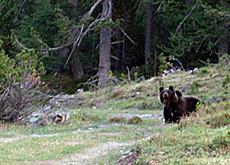Bears must stick to rules – or be shot

A month after neighbouring Germany gunned down an errant bear, Bruno, the government has issued guidelines on how the animals can avoid a similar fate in Switzerland.
The “Bear Strategy”, published on Tuesday, maintains that bears and humans can co-exist peacefully but enables regional authorities to shoot-to-kill if public safety is threatened.
The strategy document was widely criticised by mountain communities, hunters and farmers when it was put out for consultation earlier this year.
They said the federal authorities needed to make it easier to shoot troublesome animals – and the government has now taken on board their concerns.
The new guidelines, which will be issued to cantons shortly, stress that “public safety is paramount”.
Bears will now fall into three categories: “unobtrusive”, “problematic” and “high-risk”. A bear can be killed once it becomes “high-risk”: if it is no longer scared of humans despite efforts to scare it off and if it has become aggressive towards them.
A “problematic” bear is defined as one that is not afraid of humans, starts foraging for food in residential areas or kills large numbers of livestock.
“In the case of a problematic bear we would capture it, fit it with a tracking device and try to educate it to stay away from humans and livestock. To do this, we would shoot pellets, use dogs and loud noise to try to drive the animal away when it gets close to inhabited areas,” Reinhard Schnidrig, head of the hunting and game division at the Federal Environment Office, told swissinfo.
“But if the bear doesn’t learn, then it becomes a risk – and as a last resort we would have to shoot it. If ever a bear became aggressive towards humans, it would immediately be shot.”
Shoot to kill
Permission to kill a bear would be granted by the cantonal authorities following consultation with an intercantonal commission and the environment office.
The guidelines, which were drawn up by the environment office, also clarify how farmers will be compensated for the loss of livestock.
Up to 80 per cent of a claim will be met by the government, with the remainder picked by the canton concerned. Damage to beehives or animal hutches, for example, will be wholly covered by the state.
The authorities acted after a brown bear was spotted several times in Switzerland in July last year. It was the first to be seen in the country in more than a century.
“JJ2” – Bruno’s brother – stirred up a fair bit of controversy, killing one calf and more than 20 sheep, before disappearing. He came from an established population of brown bears in Italy’s Trentino region around 70km from the Swiss border.
“No one knows if he is still alive or where he is,” said Schnidrig, who added that JJ2 would have been classed as “problematic” under the new guidelines.
Awareness programmes
The government is to launch regional awareness programmes to educate the public on how to live with bears. These will include warnings that on no account must the animals be fed regularly.
Conservation group WWF Switzerland, which welcomed the strategy document, stressed that the public had a major part to play in ensuring that humans and bears could co-exist.
“The bear is a wild and timid animal, but if it is fed it will lose its natural shyness and approach inhabited areas,” said spokeswoman Joanna Schoenenberger.
Farmers, however, remain sceptical over whether bears have a future in Switzerland.
“It will be difficult for bears, humans and other animals to co-exist,” said Thomas Jäggi, spokesman for the Swiss Farmers’ Association.
swissinfo, Adam Beaumont
Bears, along with wolves and lynx, were hunted to extinction in the Alps in the 19th century. The last bear in Switzerland was killed in 1904.
A single male brown bear appeared in the Müstair valley in southeast Switzerland last July, crossing over from the Italian side of the border.
In anticipation of more bears straying into the country, the Federal Environment Office has issued guidelines for the management of bears on Swiss territory.
There are an estimated 50,000 brown bears in Europe in separate fragmented populations.
Brown bears are omnivores and feed on plants, berries, roots, fungi, fish, insects and small mammals.
They like to den in a protected spot during the winter months.
Male brown bears can grow to 350kg, females to 200kg.

In compliance with the JTI standards
More: SWI swissinfo.ch certified by the Journalism Trust Initiative










You can find an overview of ongoing debates with our journalists here . Please join us!
If you want to start a conversation about a topic raised in this article or want to report factual errors, email us at english@swissinfo.ch.